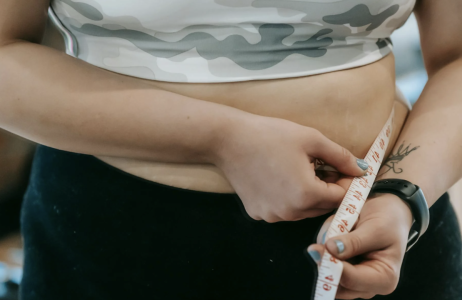What your waistline might reveal about your future health
By
Veronica E.
- Replies 0
Disclaimer: The information provided in this article is for educational purposes only and is not intended as a substitute for professional medical advice, diagnosis, or treatment. Always consult your physician or other qualified healthcare providers with any questions you may have regarding a medical condition or before making any changes to your health regimen.
Imagine being able to spot signs of your future health just by taking a few measurements at home.
While we can’t predict exactly how many birthdays we’ll celebrate, scientists are discovering simple physical clues that might hint at how well we’ll age—and how long we might live.
New research suggests that certain body measurements could help forecast your mobility, independence, and even your risk of chronic conditions.
It’s not about obsessing over the scale—it’s about staying informed and making small changes that add up to better health over time.
Here's what experts are now saying, and how you can put this knowledge to work starting today.

Why waist size matters more than you think
We’ve long heard that it’s important to maintain a healthy weight.
But where you carry extra fat might matter even more than how much you weigh.
A large-scale study from Italy found that adults with a wider waist compared to their hips were significantly more likely to face mobility issues as they aged.
Specifically, those with a high waist-to-hip ratio were 28% more likely to experience difficulty getting around.
This finding isn’t just about appearances.
Carrying more fat around the waist can affect your balance, strain your organs, and reduce stamina.
For older adults, that could mean fewer years of physical independence and a higher risk of serious illness.
Also read: Is your body shape putting you at risk for Alzheimer's? See how you compare to recent study findings!
The risks of belly fat—and how common it is
Belly fat, also called visceral fat, doesn’t just sit under your skin—it wraps around organs and interferes with their function.
It’s linked to an increased risk of diabetes, heart disease, and reduced endurance, all of which are common concerns for aging adults.
In the same study, 71% of men and 53% of women had waist-to-height ratios that fell into the high-risk category.
When researchers looked at waist-to-hip ratios, 61% of men and 39% of women were flagged for elevated risk.
Those numbers show just how widespread the issue is—and why it’s worth paying attention to.
Also read: How beauty standards have changed over the last 100 years—and why your era’s look might be back in style
Try these easy at-home health checks
You don’t need fancy equipment or a trip to the doctor to get a sense of your risk.
Here are two simple tests you can try at home using a tape measure:
Waist-to-hip ratio
Waist-to-height ratio
If your results are above the recommended numbers, it’s a good idea to speak with your doctor.
These tests aren’t a diagnosis, but they can help guide further discussions about your health.
Also read: Lower your calorie intake fast with these 11 simple food substitutes!
Other physical signs that may predict longevity
Waist size isn’t the only indicator of how well you’ll age.
Researchers have also found that other simple physical signs can point to long-term health:
Also read: Nature’s way, so no prescription is needed: How diet can mimic the effects of Ozempic
Healthy habits to help protect your future
Even if your numbers are higher than recommended, the good news is that lifestyle changes can make a big difference.
It’s never too late to take steps that protect your health and improve your day-to-day life.
Here are some ways to start:
Also read: Could this creamy fruit help you sleep better? Science says yes
Every body is different—so take measurements with care
While these at-home assessments are helpful, no single measurement can tell the full story.
The Italian study is a valuable starting point, but it doesn’t account for differences in genetics, ethnicity, or age.
So take the results as general guidance, not a guarantee.
What’s most important is staying engaged with your health and paying attention to signs your body may be giving you.
These simple tools can help you feel empowered—not overwhelmed—as you make choices that support your longevity and independence.
Read next: 6 foods dietitians say can boost your health after 60

Have you ever tracked your waist size or noticed changes in your walking speed or balance? What’s helped you stay healthy and active through the years? We’d love to hear your experiences or tips in the comments!
Imagine being able to spot signs of your future health just by taking a few measurements at home.
While we can’t predict exactly how many birthdays we’ll celebrate, scientists are discovering simple physical clues that might hint at how well we’ll age—and how long we might live.
New research suggests that certain body measurements could help forecast your mobility, independence, and even your risk of chronic conditions.
It’s not about obsessing over the scale—it’s about staying informed and making small changes that add up to better health over time.
Here's what experts are now saying, and how you can put this knowledge to work starting today.

Simple at-home measurements like waist size or walking pace may provide valuable clues about long-term health. Image Source: Pexels / Andres Ayrton.
Why waist size matters more than you think
We’ve long heard that it’s important to maintain a healthy weight.
But where you carry extra fat might matter even more than how much you weigh.
A large-scale study from Italy found that adults with a wider waist compared to their hips were significantly more likely to face mobility issues as they aged.
Specifically, those with a high waist-to-hip ratio were 28% more likely to experience difficulty getting around.
This finding isn’t just about appearances.
Carrying more fat around the waist can affect your balance, strain your organs, and reduce stamina.
For older adults, that could mean fewer years of physical independence and a higher risk of serious illness.
Also read: Is your body shape putting you at risk for Alzheimer's? See how you compare to recent study findings!
The risks of belly fat—and how common it is
Belly fat, also called visceral fat, doesn’t just sit under your skin—it wraps around organs and interferes with their function.
It’s linked to an increased risk of diabetes, heart disease, and reduced endurance, all of which are common concerns for aging adults.
In the same study, 71% of men and 53% of women had waist-to-height ratios that fell into the high-risk category.
When researchers looked at waist-to-hip ratios, 61% of men and 39% of women were flagged for elevated risk.
Those numbers show just how widespread the issue is—and why it’s worth paying attention to.
Also read: How beauty standards have changed over the last 100 years—and why your era’s look might be back in style
Try these easy at-home health checks
You don’t need fancy equipment or a trip to the doctor to get a sense of your risk.
Here are two simple tests you can try at home using a tape measure:
Waist-to-hip ratio
- Measure your waist at its narrowest point, usually just above the belly button.
- Measure your hips at their widest point.
- Divide your waist measurement by your hip measurement.
- A result over 0.90 for men or 0.85 for women may indicate higher risk.
Waist-to-height ratio
- Measure your waist as above.
- Divide your waist measurement by your height.
- A ratio above 0.5 is considered a warning sign for both men and women.
If your results are above the recommended numbers, it’s a good idea to speak with your doctor.
These tests aren’t a diagnosis, but they can help guide further discussions about your health.
Also read: Lower your calorie intake fast with these 11 simple food substitutes!
Other physical signs that may predict longevity
Waist size isn’t the only indicator of how well you’ll age.
Researchers have also found that other simple physical signs can point to long-term health:
- Grip strength: A firm handshake or the ability to hold onto objects strongly is linked to longer life and better heart health.
- Walking speed: How quickly you walk may reflect your overall physical condition and is even used in some studies as a measure of biological age.
- Balance: Being able to stand on one leg for 10 seconds or more has been associated with better cognitive and cardiovascular health.
- Blood markers: Routine blood tests that check cholesterol, blood sugar, and inflammation also offer insight into long-term risk.
Also read: Nature’s way, so no prescription is needed: How diet can mimic the effects of Ozempic
Healthy habits to help protect your future
Even if your numbers are higher than recommended, the good news is that lifestyle changes can make a big difference.
It’s never too late to take steps that protect your health and improve your day-to-day life.
Here are some ways to start:
- Move regularly: Try for 150 minutes of moderate physical activity each week. Walks, gardening, water aerobics, or dancing can all help.
- Watch your nutrition: Stick to balanced meals with lean protein, whole grains, vegetables, and fruit. Cut back on sugary drinks and processed snacks.
- Strengthen your middle: Gentle core exercises, chair stretches, or yoga can improve balance and reduce waist size over time.
- Stay connected: Regular social interaction is linked to better emotional health and cognitive function.
- See your doctor: Routine check-ups help track changes and catch potential problems before they become serious.
Also read: Could this creamy fruit help you sleep better? Science says yes
Every body is different—so take measurements with care
While these at-home assessments are helpful, no single measurement can tell the full story.
The Italian study is a valuable starting point, but it doesn’t account for differences in genetics, ethnicity, or age.
So take the results as general guidance, not a guarantee.
What’s most important is staying engaged with your health and paying attention to signs your body may be giving you.
These simple tools can help you feel empowered—not overwhelmed—as you make choices that support your longevity and independence.
Read next: 6 foods dietitians say can boost your health after 60
Key Takeaways
- Research shows that where fat is carried on your body—especially around the waist—can be a stronger indicator of health risks than total body weight.
- An Italian study found that adults with higher waist-to-hip ratios were 28% more likely to develop mobility problems as they age.
- Simple at-home tests like waist-to-hip and waist-to-height ratios can help identify risk, with over half of study participants falling into high-risk categories.
- Additional health indicators like grip strength, walking speed, and balance may also offer clues about longevity and overall well-being.
Have you ever tracked your waist size or noticed changes in your walking speed or balance? What’s helped you stay healthy and active through the years? We’d love to hear your experiences or tips in the comments!






